Business Proposal: Xiaomi's Market Entry and Expansion in Ghana
VerifiedAdded on 2022/11/29
|8
|2017
|337
Report
AI Summary
This business proposal outlines Xiaomi's strategy for entering the Ghanaian market. It begins with an introduction, aims, and objectives, followed by a discussion of segmentation, targeting, and positioning strategies. The report then delves into the marketing mix, including product, place, price, promotion, people, process, and physical evidence. A SWOT analysis of Xiaomi is provided, highlighting its strengths, weaknesses, opportunities, and threats. The proposal concludes with a discussion of market entry strategies, including direct exporting, franchising, joint ventures, and licensing, recommending direct exporting as the most suitable approach. The report leverages various sources to support its analysis and recommendations.

Business proposal
Paraphrase This Document
Need a fresh take? Get an instant paraphrase of this document with our AI Paraphraser
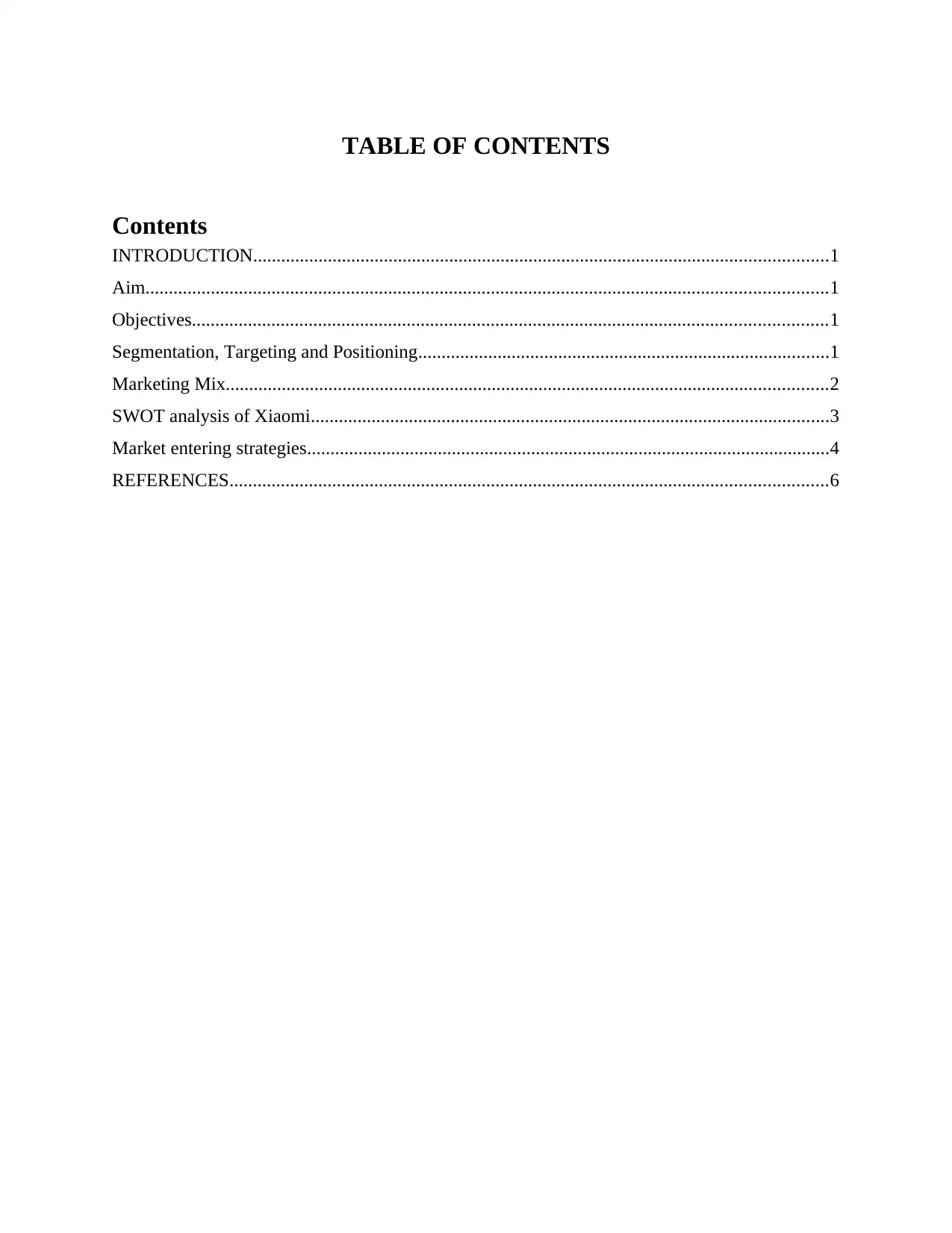
TABLE OF CONTENTS
Contents
INTRODUCTION...........................................................................................................................1
Aim..................................................................................................................................................1
Objectives........................................................................................................................................1
Segmentation, Targeting and Positioning........................................................................................1
Marketing Mix.................................................................................................................................2
SWOT analysis of Xiaomi...............................................................................................................3
Market entering strategies................................................................................................................4
REFERENCES................................................................................................................................6
Contents
INTRODUCTION...........................................................................................................................1
Aim..................................................................................................................................................1
Objectives........................................................................................................................................1
Segmentation, Targeting and Positioning........................................................................................1
Marketing Mix.................................................................................................................................2
SWOT analysis of Xiaomi...............................................................................................................3
Market entering strategies................................................................................................................4
REFERENCES................................................................................................................................6
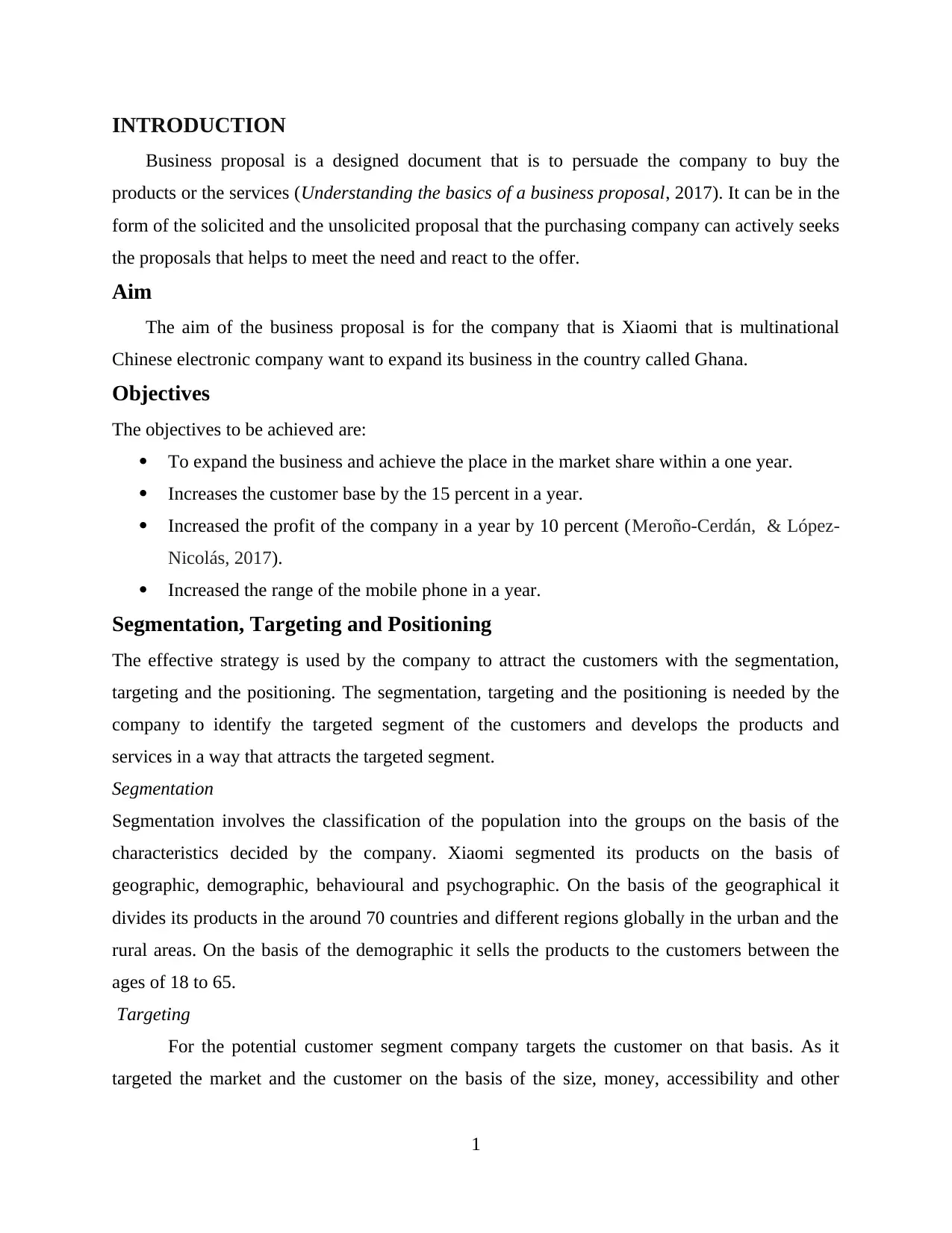
INTRODUCTION
Business proposal is a designed document that is to persuade the company to buy the
products or the services (Understanding the basics of a business proposal, 2017). It can be in the
form of the solicited and the unsolicited proposal that the purchasing company can actively seeks
the proposals that helps to meet the need and react to the offer.
Aim
The aim of the business proposal is for the company that is Xiaomi that is multinational
Chinese electronic company want to expand its business in the country called Ghana.
Objectives
The objectives to be achieved are:
To expand the business and achieve the place in the market share within a one year.
Increases the customer base by the 15 percent in a year.
Increased the profit of the company in a year by 10 percent (Meroño-Cerdán, & López-
Nicolás, 2017).
Increased the range of the mobile phone in a year.
Segmentation, Targeting and Positioning
The effective strategy is used by the company to attract the customers with the segmentation,
targeting and the positioning. The segmentation, targeting and the positioning is needed by the
company to identify the targeted segment of the customers and develops the products and
services in a way that attracts the targeted segment.
Segmentation
Segmentation involves the classification of the population into the groups on the basis of the
characteristics decided by the company. Xiaomi segmented its products on the basis of
geographic, demographic, behavioural and psychographic. On the basis of the geographical it
divides its products in the around 70 countries and different regions globally in the urban and the
rural areas. On the basis of the demographic it sells the products to the customers between the
ages of 18 to 65.
Targeting
For the potential customer segment company targets the customer on that basis. As it
targeted the market and the customer on the basis of the size, money, accessibility and other
1
Business proposal is a designed document that is to persuade the company to buy the
products or the services (Understanding the basics of a business proposal, 2017). It can be in the
form of the solicited and the unsolicited proposal that the purchasing company can actively seeks
the proposals that helps to meet the need and react to the offer.
Aim
The aim of the business proposal is for the company that is Xiaomi that is multinational
Chinese electronic company want to expand its business in the country called Ghana.
Objectives
The objectives to be achieved are:
To expand the business and achieve the place in the market share within a one year.
Increases the customer base by the 15 percent in a year.
Increased the profit of the company in a year by 10 percent (Meroño-Cerdán, & López-
Nicolás, 2017).
Increased the range of the mobile phone in a year.
Segmentation, Targeting and Positioning
The effective strategy is used by the company to attract the customers with the segmentation,
targeting and the positioning. The segmentation, targeting and the positioning is needed by the
company to identify the targeted segment of the customers and develops the products and
services in a way that attracts the targeted segment.
Segmentation
Segmentation involves the classification of the population into the groups on the basis of the
characteristics decided by the company. Xiaomi segmented its products on the basis of
geographic, demographic, behavioural and psychographic. On the basis of the geographical it
divides its products in the around 70 countries and different regions globally in the urban and the
rural areas. On the basis of the demographic it sells the products to the customers between the
ages of 18 to 65.
Targeting
For the potential customer segment company targets the customer on that basis. As it
targeted the market and the customer on the basis of the size, money, accessibility and other
1
⊘ This is a preview!⊘
Do you want full access?
Subscribe today to unlock all pages.

Trusted by 1+ million students worldwide
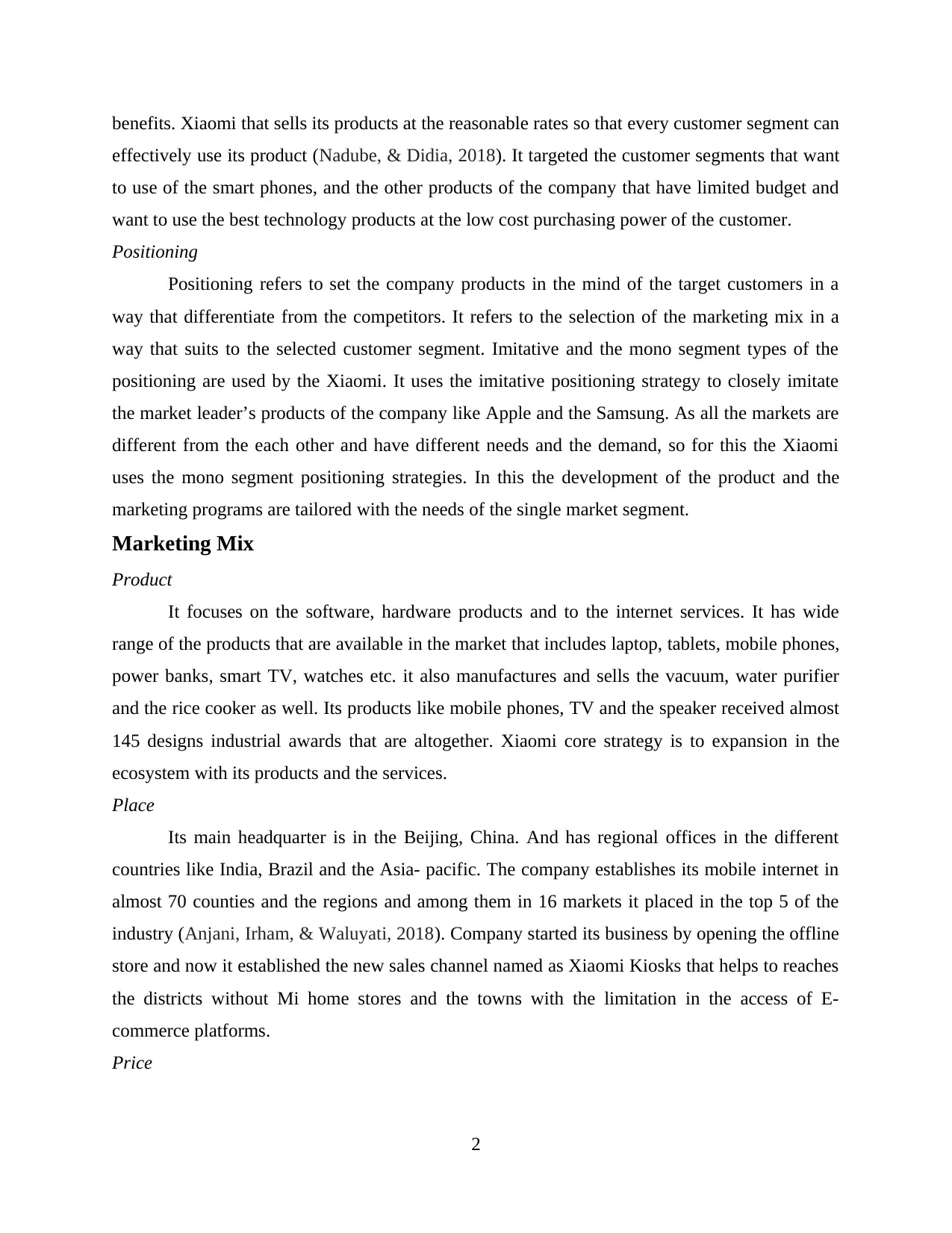
benefits. Xiaomi that sells its products at the reasonable rates so that every customer segment can
effectively use its product (Nadube, & Didia, 2018). It targeted the customer segments that want
to use of the smart phones, and the other products of the company that have limited budget and
want to use the best technology products at the low cost purchasing power of the customer.
Positioning
Positioning refers to set the company products in the mind of the target customers in a
way that differentiate from the competitors. It refers to the selection of the marketing mix in a
way that suits to the selected customer segment. Imitative and the mono segment types of the
positioning are used by the Xiaomi. It uses the imitative positioning strategy to closely imitate
the market leader’s products of the company like Apple and the Samsung. As all the markets are
different from the each other and have different needs and the demand, so for this the Xiaomi
uses the mono segment positioning strategies. In this the development of the product and the
marketing programs are tailored with the needs of the single market segment.
Marketing Mix
Product
It focuses on the software, hardware products and to the internet services. It has wide
range of the products that are available in the market that includes laptop, tablets, mobile phones,
power banks, smart TV, watches etc. it also manufactures and sells the vacuum, water purifier
and the rice cooker as well. Its products like mobile phones, TV and the speaker received almost
145 designs industrial awards that are altogether. Xiaomi core strategy is to expansion in the
ecosystem with its products and the services.
Place
Its main headquarter is in the Beijing, China. And has regional offices in the different
countries like India, Brazil and the Asia- pacific. The company establishes its mobile internet in
almost 70 counties and the regions and among them in 16 markets it placed in the top 5 of the
industry (Anjani, Irham, & Waluyati, 2018). Company started its business by opening the offline
store and now it established the new sales channel named as Xiaomi Kiosks that helps to reaches
the districts without Mi home stores and the towns with the limitation in the access of E-
commerce platforms.
Price
2
effectively use its product (Nadube, & Didia, 2018). It targeted the customer segments that want
to use of the smart phones, and the other products of the company that have limited budget and
want to use the best technology products at the low cost purchasing power of the customer.
Positioning
Positioning refers to set the company products in the mind of the target customers in a
way that differentiate from the competitors. It refers to the selection of the marketing mix in a
way that suits to the selected customer segment. Imitative and the mono segment types of the
positioning are used by the Xiaomi. It uses the imitative positioning strategy to closely imitate
the market leader’s products of the company like Apple and the Samsung. As all the markets are
different from the each other and have different needs and the demand, so for this the Xiaomi
uses the mono segment positioning strategies. In this the development of the product and the
marketing programs are tailored with the needs of the single market segment.
Marketing Mix
Product
It focuses on the software, hardware products and to the internet services. It has wide
range of the products that are available in the market that includes laptop, tablets, mobile phones,
power banks, smart TV, watches etc. it also manufactures and sells the vacuum, water purifier
and the rice cooker as well. Its products like mobile phones, TV and the speaker received almost
145 designs industrial awards that are altogether. Xiaomi core strategy is to expansion in the
ecosystem with its products and the services.
Place
Its main headquarter is in the Beijing, China. And has regional offices in the different
countries like India, Brazil and the Asia- pacific. The company establishes its mobile internet in
almost 70 counties and the regions and among them in 16 markets it placed in the top 5 of the
industry (Anjani, Irham, & Waluyati, 2018). Company started its business by opening the offline
store and now it established the new sales channel named as Xiaomi Kiosks that helps to reaches
the districts without Mi home stores and the towns with the limitation in the access of E-
commerce platforms.
Price
2
Paraphrase This Document
Need a fresh take? Get an instant paraphrase of this document with our AI Paraphraser
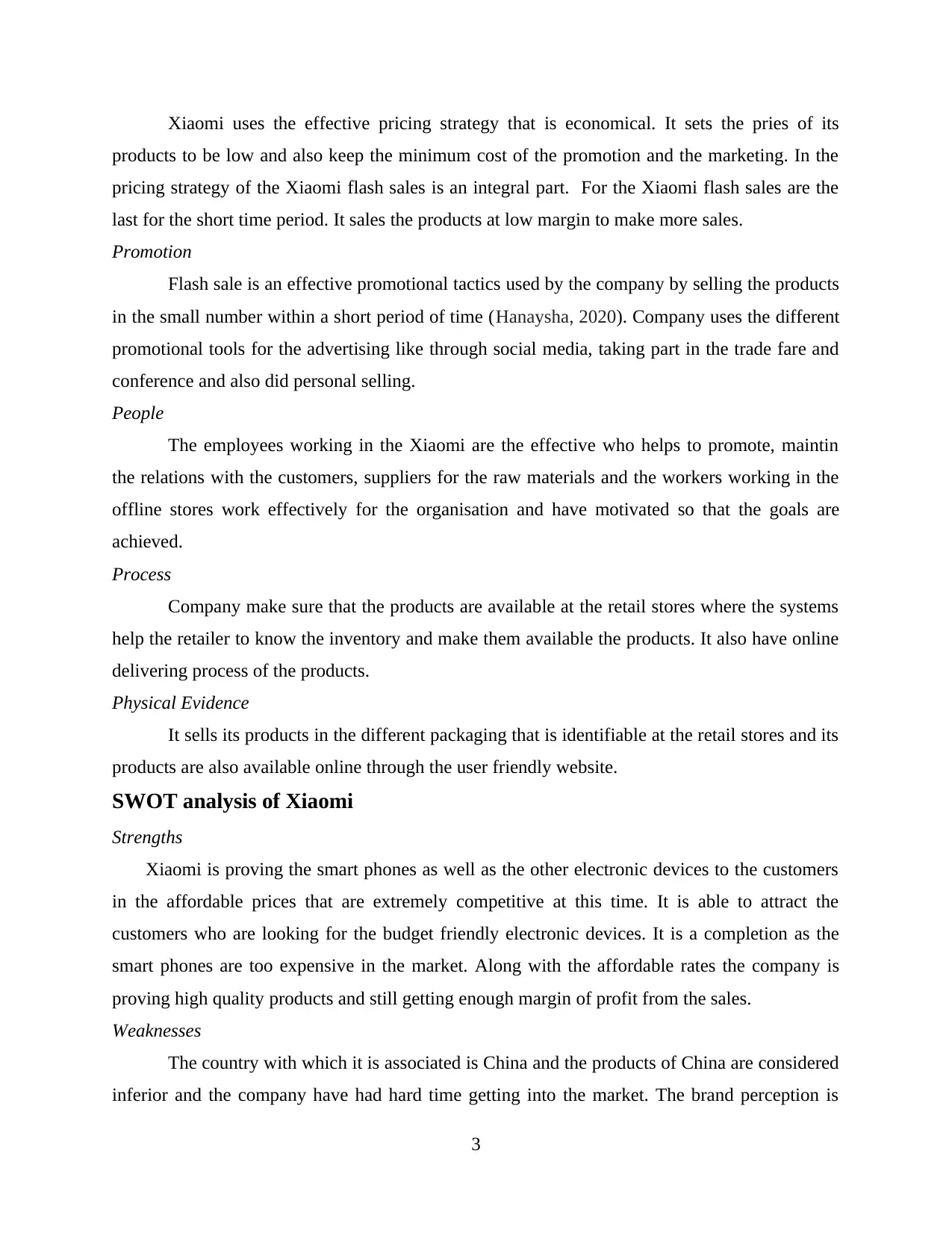
Xiaomi uses the effective pricing strategy that is economical. It sets the pries of its
products to be low and also keep the minimum cost of the promotion and the marketing. In the
pricing strategy of the Xiaomi flash sales is an integral part. For the Xiaomi flash sales are the
last for the short time period. It sales the products at low margin to make more sales.
Promotion
Flash sale is an effective promotional tactics used by the company by selling the products
in the small number within a short period of time (Hanaysha, 2020). Company uses the different
promotional tools for the advertising like through social media, taking part in the trade fare and
conference and also did personal selling.
People
The employees working in the Xiaomi are the effective who helps to promote, maintin
the relations with the customers, suppliers for the raw materials and the workers working in the
offline stores work effectively for the organisation and have motivated so that the goals are
achieved.
Process
Company make sure that the products are available at the retail stores where the systems
help the retailer to know the inventory and make them available the products. It also have online
delivering process of the products.
Physical Evidence
It sells its products in the different packaging that is identifiable at the retail stores and its
products are also available online through the user friendly website.
SWOT analysis of Xiaomi
Strengths
Xiaomi is proving the smart phones as well as the other electronic devices to the customers
in the affordable prices that are extremely competitive at this time. It is able to attract the
customers who are looking for the budget friendly electronic devices. It is a completion as the
smart phones are too expensive in the market. Along with the affordable rates the company is
proving high quality products and still getting enough margin of profit from the sales.
Weaknesses
The country with which it is associated is China and the products of China are considered
inferior and the company have had hard time getting into the market. The brand perception is
3
products to be low and also keep the minimum cost of the promotion and the marketing. In the
pricing strategy of the Xiaomi flash sales is an integral part. For the Xiaomi flash sales are the
last for the short time period. It sales the products at low margin to make more sales.
Promotion
Flash sale is an effective promotional tactics used by the company by selling the products
in the small number within a short period of time (Hanaysha, 2020). Company uses the different
promotional tools for the advertising like through social media, taking part in the trade fare and
conference and also did personal selling.
People
The employees working in the Xiaomi are the effective who helps to promote, maintin
the relations with the customers, suppliers for the raw materials and the workers working in the
offline stores work effectively for the organisation and have motivated so that the goals are
achieved.
Process
Company make sure that the products are available at the retail stores where the systems
help the retailer to know the inventory and make them available the products. It also have online
delivering process of the products.
Physical Evidence
It sells its products in the different packaging that is identifiable at the retail stores and its
products are also available online through the user friendly website.
SWOT analysis of Xiaomi
Strengths
Xiaomi is proving the smart phones as well as the other electronic devices to the customers
in the affordable prices that are extremely competitive at this time. It is able to attract the
customers who are looking for the budget friendly electronic devices. It is a completion as the
smart phones are too expensive in the market. Along with the affordable rates the company is
proving high quality products and still getting enough margin of profit from the sales.
Weaknesses
The country with which it is associated is China and the products of China are considered
inferior and the company have had hard time getting into the market. The brand perception is
3
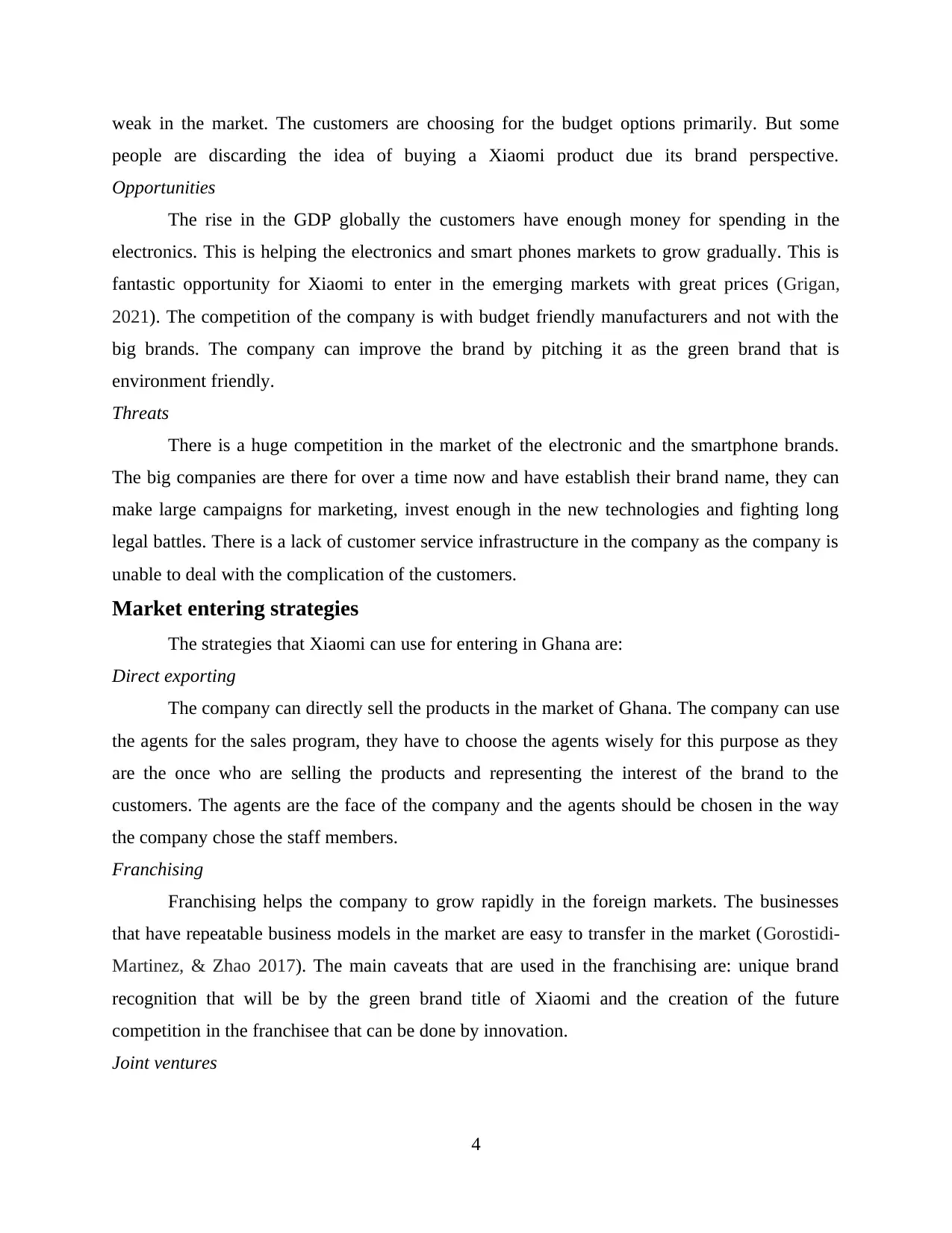
weak in the market. The customers are choosing for the budget options primarily. But some
people are discarding the idea of buying a Xiaomi product due its brand perspective.
Opportunities
The rise in the GDP globally the customers have enough money for spending in the
electronics. This is helping the electronics and smart phones markets to grow gradually. This is
fantastic opportunity for Xiaomi to enter in the emerging markets with great prices (Grigan,
2021). The competition of the company is with budget friendly manufacturers and not with the
big brands. The company can improve the brand by pitching it as the green brand that is
environment friendly.
Threats
There is a huge competition in the market of the electronic and the smartphone brands.
The big companies are there for over a time now and have establish their brand name, they can
make large campaigns for marketing, invest enough in the new technologies and fighting long
legal battles. There is a lack of customer service infrastructure in the company as the company is
unable to deal with the complication of the customers.
Market entering strategies
The strategies that Xiaomi can use for entering in Ghana are:
Direct exporting
The company can directly sell the products in the market of Ghana. The company can use
the agents for the sales program, they have to choose the agents wisely for this purpose as they
are the once who are selling the products and representing the interest of the brand to the
customers. The agents are the face of the company and the agents should be chosen in the way
the company chose the staff members.
Franchising
Franchising helps the company to grow rapidly in the foreign markets. The businesses
that have repeatable business models in the market are easy to transfer in the market (Gorostidi-
Martinez, & Zhao 2017). The main caveats that are used in the franchising are: unique brand
recognition that will be by the green brand title of Xiaomi and the creation of the future
competition in the franchisee that can be done by innovation.
Joint ventures
4
people are discarding the idea of buying a Xiaomi product due its brand perspective.
Opportunities
The rise in the GDP globally the customers have enough money for spending in the
electronics. This is helping the electronics and smart phones markets to grow gradually. This is
fantastic opportunity for Xiaomi to enter in the emerging markets with great prices (Grigan,
2021). The competition of the company is with budget friendly manufacturers and not with the
big brands. The company can improve the brand by pitching it as the green brand that is
environment friendly.
Threats
There is a huge competition in the market of the electronic and the smartphone brands.
The big companies are there for over a time now and have establish their brand name, they can
make large campaigns for marketing, invest enough in the new technologies and fighting long
legal battles. There is a lack of customer service infrastructure in the company as the company is
unable to deal with the complication of the customers.
Market entering strategies
The strategies that Xiaomi can use for entering in Ghana are:
Direct exporting
The company can directly sell the products in the market of Ghana. The company can use
the agents for the sales program, they have to choose the agents wisely for this purpose as they
are the once who are selling the products and representing the interest of the brand to the
customers. The agents are the face of the company and the agents should be chosen in the way
the company chose the staff members.
Franchising
Franchising helps the company to grow rapidly in the foreign markets. The businesses
that have repeatable business models in the market are easy to transfer in the market (Gorostidi-
Martinez, & Zhao 2017). The main caveats that are used in the franchising are: unique brand
recognition that will be by the green brand title of Xiaomi and the creation of the future
competition in the franchisee that can be done by innovation.
Joint ventures
4
⊘ This is a preview!⊘
Do you want full access?
Subscribe today to unlock all pages.

Trusted by 1+ million students worldwide
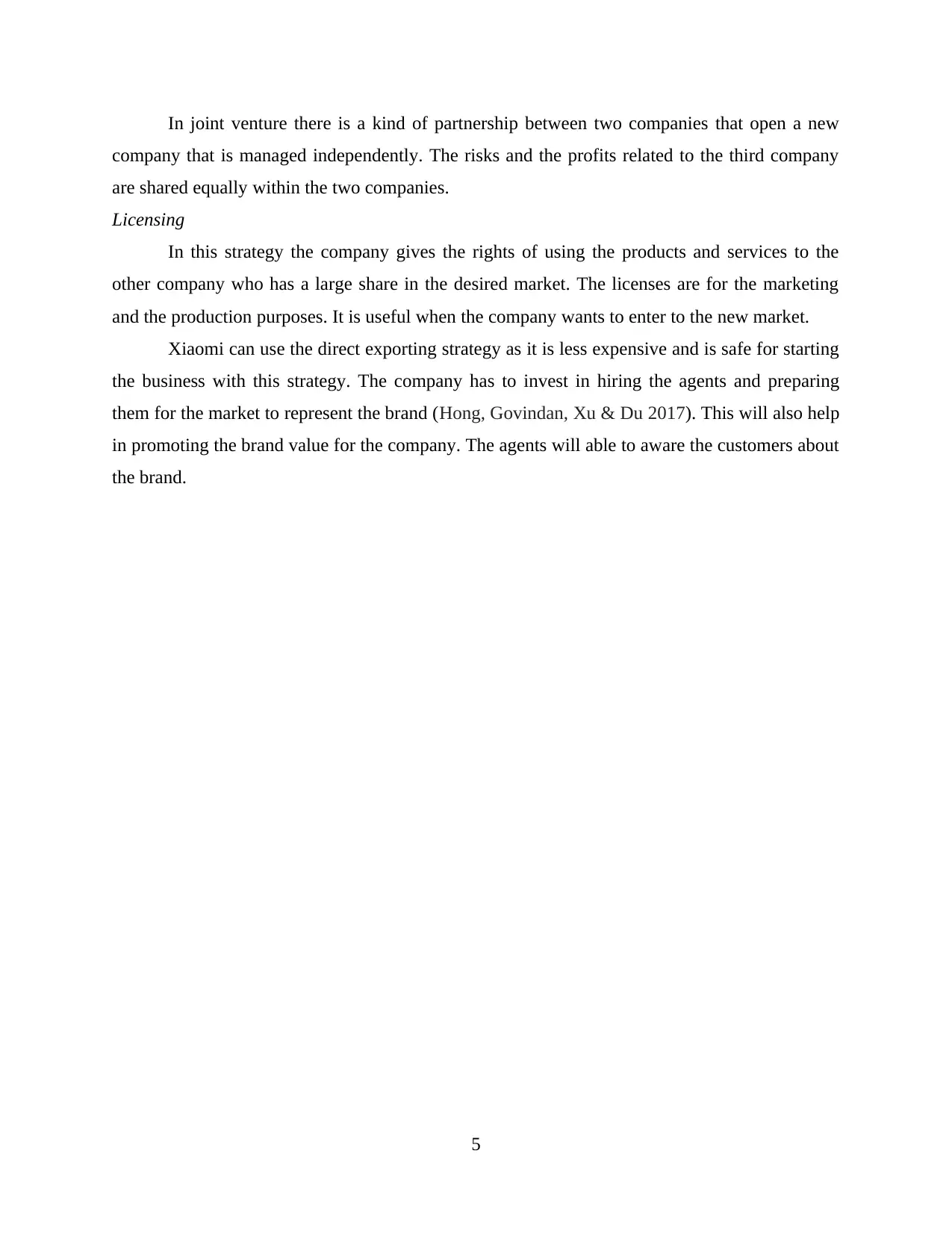
In joint venture there is a kind of partnership between two companies that open a new
company that is managed independently. The risks and the profits related to the third company
are shared equally within the two companies.
Licensing
In this strategy the company gives the rights of using the products and services to the
other company who has a large share in the desired market. The licenses are for the marketing
and the production purposes. It is useful when the company wants to enter to the new market.
Xiaomi can use the direct exporting strategy as it is less expensive and is safe for starting
the business with this strategy. The company has to invest in hiring the agents and preparing
them for the market to represent the brand (Hong, Govindan, Xu & Du 2017). This will also help
in promoting the brand value for the company. The agents will able to aware the customers about
the brand.
5
company that is managed independently. The risks and the profits related to the third company
are shared equally within the two companies.
Licensing
In this strategy the company gives the rights of using the products and services to the
other company who has a large share in the desired market. The licenses are for the marketing
and the production purposes. It is useful when the company wants to enter to the new market.
Xiaomi can use the direct exporting strategy as it is less expensive and is safe for starting
the business with this strategy. The company has to invest in hiring the agents and preparing
them for the market to represent the brand (Hong, Govindan, Xu & Du 2017). This will also help
in promoting the brand value for the company. The agents will able to aware the customers about
the brand.
5
Paraphrase This Document
Need a fresh take? Get an instant paraphrase of this document with our AI Paraphraser
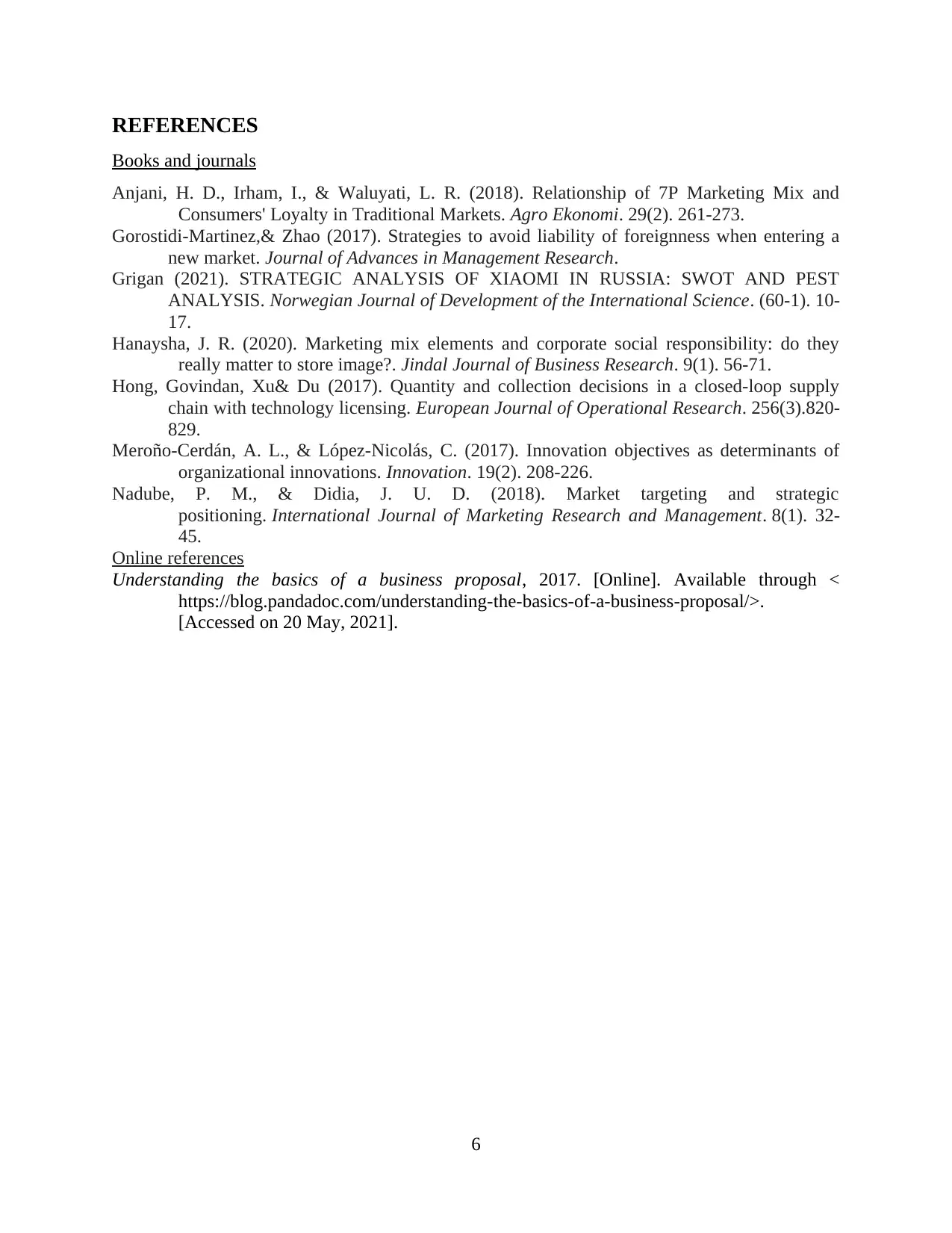
REFERENCES
Books and journals
Anjani, H. D., Irham, I., & Waluyati, L. R. (2018). Relationship of 7P Marketing Mix and
Consumers' Loyalty in Traditional Markets. Agro Ekonomi. 29(2). 261-273.
Gorostidi-Martinez,& Zhao (2017). Strategies to avoid liability of foreignness when entering a
new market. Journal of Advances in Management Research.
Grigan (2021). STRATEGIC ANALYSIS OF XIAOMI IN RUSSIA: SWOT AND PEST
ANALYSIS. Norwegian Journal of Development of the International Science. (60-1). 10-
17.
Hanaysha, J. R. (2020). Marketing mix elements and corporate social responsibility: do they
really matter to store image?. Jindal Journal of Business Research. 9(1). 56-71.
Hong, Govindan, Xu& Du (2017). Quantity and collection decisions in a closed-loop supply
chain with technology licensing. European Journal of Operational Research. 256(3).820-
829.
Meroño-Cerdán, A. L., & López-Nicolás, C. (2017). Innovation objectives as determinants of
organizational innovations. Innovation. 19(2). 208-226.
Nadube, P. M., & Didia, J. U. D. (2018). Market targeting and strategic
positioning. International Journal of Marketing Research and Management. 8(1). 32-
45.
Online references
Understanding the basics of a business proposal, 2017. [Online]. Available through <
https://blog.pandadoc.com/understanding-the-basics-of-a-business-proposal/>.
[Accessed on 20 May, 2021].
6
Books and journals
Anjani, H. D., Irham, I., & Waluyati, L. R. (2018). Relationship of 7P Marketing Mix and
Consumers' Loyalty in Traditional Markets. Agro Ekonomi. 29(2). 261-273.
Gorostidi-Martinez,& Zhao (2017). Strategies to avoid liability of foreignness when entering a
new market. Journal of Advances in Management Research.
Grigan (2021). STRATEGIC ANALYSIS OF XIAOMI IN RUSSIA: SWOT AND PEST
ANALYSIS. Norwegian Journal of Development of the International Science. (60-1). 10-
17.
Hanaysha, J. R. (2020). Marketing mix elements and corporate social responsibility: do they
really matter to store image?. Jindal Journal of Business Research. 9(1). 56-71.
Hong, Govindan, Xu& Du (2017). Quantity and collection decisions in a closed-loop supply
chain with technology licensing. European Journal of Operational Research. 256(3).820-
829.
Meroño-Cerdán, A. L., & López-Nicolás, C. (2017). Innovation objectives as determinants of
organizational innovations. Innovation. 19(2). 208-226.
Nadube, P. M., & Didia, J. U. D. (2018). Market targeting and strategic
positioning. International Journal of Marketing Research and Management. 8(1). 32-
45.
Online references
Understanding the basics of a business proposal, 2017. [Online]. Available through <
https://blog.pandadoc.com/understanding-the-basics-of-a-business-proposal/>.
[Accessed on 20 May, 2021].
6
1 out of 8
Related Documents
Your All-in-One AI-Powered Toolkit for Academic Success.
+13062052269
info@desklib.com
Available 24*7 on WhatsApp / Email
![[object Object]](/_next/static/media/star-bottom.7253800d.svg)
Unlock your academic potential
Copyright © 2020–2025 A2Z Services. All Rights Reserved. Developed and managed by ZUCOL.




